MIA1402
antibody from Invitrogen Antibodies
Targeting: APOA1
 Western blot
Western blot ELISA
ELISA Immunocytochemistry
Immunocytochemistry Immunoprecipitation
Immunoprecipitation Immunohistochemistry
Immunohistochemistry Flow cytometry
Flow cytometry Radioimmunoassay
Radioimmunoassay Other assay
Other assayAntibody data
- Antibody Data
- Antigen structure
- References [2]
- Comments [0]
- Validations
- ELISA [5]
- Immunocytochemistry [2]
- Immunohistochemistry [1]
- Flow cytometry [1]
- Other assay [2]
Submit
Validation data
Reference
Comment
Report error
- Product number
- MIA1402 - Provider product page

- Provider
- Invitrogen Antibodies
- Product name
- ApoA1 Monoclonal Antibody (311)
- Antibody type
- Monoclonal
- Antigen
- Purifed from natural sources
- Description
- By sandwich ELISA, MIA1402 can be used as a detection antibody with Product # 710263 or # 701239 as a coating antibody, to generate a matched pair. Using these matched pairs, recombinant human Apo A-1, but not recombinant mouse Apo A-1, was detected. MIA1402 can be used to detect Apo A-1 from serum samples. To increase sensitivity of sandwich ELISAs with MIA1402, a biotinylated detection antibody followed by Streptavidin-HRP is recommended. By Western blot, MIA1402 detects recombinant human Apo A-1, but not recombinant mouse Apo A-1. MIA1402 may not be as successful for detecting endogenous Apo A-1 by Western blot. MIA1402 was formerly sold as a Seradyn product.
- Reactivity
- Human, Mouse
- Host
- Mouse
- Isotype
- IgG
- Antibody clone number
- 311
- Vial size
- 1 mg
- Concentration
- 5 mg/mL
- Storage
- Maintain refrigerated at 2-8°C for up to 6 months. For long term storage store at -20°C
Submitted references Serum HDL cholesterol uptake capacity in subjects from the MASHAD cohort study: Its value in determining the risk of cardiovascular endpoints.
Association of ANGPTL3 polymorphisms with high-density lipoprotein cholesterol uptake capacity in patients with cardiovascular disease.
Aghasizadeh M, Samadi S, Sahebkar A, Miri-Moghaddam E, Esmaily H, Souktanloo M, Avan A, Mansoori A, Ferns GA, Kazemi T, Ghayour-Mobarhan M
Journal of clinical laboratory analysis 2021 Jun;35(6):e23770
Journal of clinical laboratory analysis 2021 Jun;35(6):e23770
Association of ANGPTL3 polymorphisms with high-density lipoprotein cholesterol uptake capacity in patients with cardiovascular disease.
Aghasizadeh M, Nosrati M, Saberi-Karimian M, Safarian H, Assadian P, Akbarpour E, Sahebkar A, Avan A, Ferns GA, Kazemi T, Miri-Moghaddam E, Ghayour-Mobarhan M
Journal of clinical laboratory analysis 2021 Dec;35(12):e23980
Journal of clinical laboratory analysis 2021 Dec;35(12):e23980
No comments: Submit comment
Supportive validation
- Submitted by
- Invitrogen Antibodies (provider)
- Main image
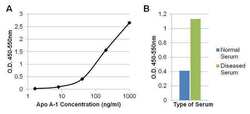
- Experimental details
- Sandwich ELISA of Apolipoprotein A-1 was performed by coating wells of a 96-well plate with 100 µL of an Apo A-1 Recombinant Rabbit Polyclonal Antibody (Product # 710263) at a concentration of 1 µg/mL in carbonate/bicarbonate buffer (Product # 28382) overnight at 4C. Wells were blocked with 150 µL of StartingBlock T20 (TBS) Blocking Buffer (Product # 37543) for 30 minutes, and 80 µL of recombinant human Apo A-1 (Product # 10686-H02H-50) standards ranging from 1.6-1000 ng/mL (A) or 100 µL of diluted normal human serum or diluted serum from a patient with dyslipidemia (B) were incubated for 1 hour at room temperature. The plate was washed with 1X TBST (Product # 28360), and 100 µL per well of an Apo A-1 Mouse Monoclonal Antibody (Product # MIA1402) was added to each well for 1 hour at room temperature. The plate was washed, and 100 µL per well of a biotinylated Rabbit anti-Mouse IgG Superclonal secondary antibody (Product # A27024) was incubated for 1 hour, followed by Streptavidin-HRP (Product # 21126) for 30 minutes. Detection was performed using 1-Step Ultra TMB Substrate (Product # 34028), followed by Stop Solution (Product # N600). Absorbances were read on a spectrophotometer at 450-550 nm.
- Submitted by
- Invitrogen Antibodies (provider)
- Main image
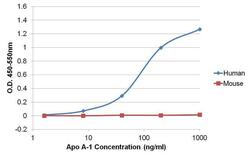
- Experimental details
- Sandwich ELISA of Apolipoprotein A-1 was performed by coating wells of a 96-well plate with 100 µL of an Apo A-1 rabbit monoclonal antibody (Product # 701239) diluted to a concentration of 1 µg/mL in carbonate/bicarbonate buffer (Product # 28382) overnight at 4C. Wells were blocked with 150 µL of StartingBlock T20 (TBS) Blocking Buffer (Product # 37543) for 30 minutes, and 80 µL of recombinant human Apo A-1 (Product # 10686-H02H-50) or recombinant mouse Apo A-1 (Product # 50918-M02H-50) was added to the plate at concentrations ranging from 1.6-1000 ng/mL and incubated for 1 hour at room temperature. The plate was washed with 1X TBST (Product # 28360), and 100 µL per well of an Apo A-1 mouse monoclonal antibody (Product # MIA1402) was added to each well for 1 hour at room temperature. The plate was washed, and 100 µL per well of an HRP-conjugated rabbit anti-mouse IgG cross-adsorbed secondary antibody (Product # 31452) was incubated for 30 minutes at room temperature. Detection was performed using 1-Step Ultra TMB Substrate (Product # 34028), followed by Stop Solution (Product # N600). Absorbances were read on a spectrophotometer at 450-550 nm.
- Submitted by
- Invitrogen Antibodies (provider)
- Main image
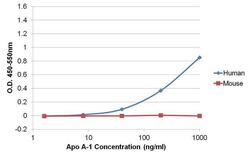
- Experimental details
- Sandwich ELISA of Apolipoprotein A-1 was performed by coating wells of a 96-well plate with 100 µL of an Apo A-1 Recombinant Rabbit Polyclonal Antibody (Product # 710263) diluted to a concentration of 1 µg/mL in carbonate/bicarbonate buffer (Product # 28382) overnight at 4C. Wells were blocked with 150 µL of StartingBlock T20 (TBS) Blocking Buffer (Product # 37543) for 30 minutes, and 80 µL of recombinant human Apo A-1 (Product # 10686-H02H-50) or recombinant mouse Apo A-1 (Product # 50918-M02H-50) was added to the plate at concentrations ranging from 1.6-1000 ng/mL and incubated for 1 hour at room temperature. The plate was washed with 1X TBST (Product # 28360), and 100 µL per well of an Apo A-1 Mouse Monoclonal Antibody (Product # MIA1402) was added to each well for 1 hour at room temperature. The plate was washed, and 100 µL per well of an HRP-conjugated Rabbit anti-Mouse IgG cross-adsorbed secondary antibody (Product # 31452) was incubated for 30 minutes at room temperature. Detection was performed using 1-Step Ultra TMB Substrate (Product # 34028), followed by Stop Solution (Product # N600). Absorbances were read on a spectrophotometer at 450-550 nm.
- Submitted by
- Invitrogen Antibodies (provider)
- Main image
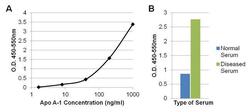
- Experimental details
- Sandwich ELISA of Apolipoprotein A-1 was performed by coating wells of a 96-well plate with 100 µL of an Apo A-1 rabbit monoclonal antibody (Product # 701239) at a concentration of 1 µg/mL in carbonate/bicarbonate buffer (Product # 28382) overnight at 4C. Wells were blocked with 150 µL of StartingBlock T20 (TBS) Blocking Buffer (Product # 37543) for 30 minutes, and 80 µL of recombinant human Apo A-1 (Product # 10686-H02H-50) standards ranging from 1.6-1000 ng/mL (A) or 100 µL of diluted normal human serum or diluted serum from a patient with dyslipidemia (B) were incubated for 1 hour at room temperature. The plate was washed with 1X TBST (Product # 28360), and 100 µL per well of an Apo A-1 mouse monoclonal antibody (Product # MIA1402) was added to each well for 1 hour at room temperature. The plate was washed, and 100 µL per well of a biotinylated rabbit anti-mouse IgG Superclonal secondary antibody (Product # A27024) was incubated for 1 hour, followed by Streptavidin-HRP (Product # 21126) for 30 minutes. Detection was performed using 1-Step Ultra TMB Substrate (Product # 34028), followed by Stop Solution (Product # N600). Absorbances were read on a spectrophotometer at 450-550 nm.
- Submitted by
- Invitrogen Antibodies (provider)
- Main image
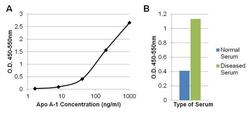
- Experimental details
- Sandwich ELISA of Apolipoprotein A-1 was performed by coating wells of a 96-well plate with 100 µL of an Apo A-1 Recombinant Rabbit Polyclonal Antibody (Product # 710263) at a concentration of 1 µg/mL in carbonate/bicarbonate buffer (Product # 28382) overnight at 4C. Wells were blocked with 150 µL of StartingBlock T20 (TBS) Blocking Buffer (Product # 37543) for 30 minutes, and 80 µL of recombinant human Apo A-1 (Product # 10686-H02H-50) standards ranging from 1.6-1000 ng/mL (A) or 100 µL of diluted normal human serum or diluted serum from a patient with dyslipidemia (B) were incubated for 1 hour at room temperature. The plate was washed with 1X TBST (Product # 28360), and 100 µL per well of an Apo A-1 Mouse Monoclonal Antibody (Product # MIA1402) was added to each well for 1 hour at room temperature. The plate was washed, and 100 µL per well of a biotinylated Rabbit anti-Mouse IgG Superclonal secondary antibody (Product # A27024) was incubated for 1 hour, followed by Streptavidin-HRP (Product # 21126) for 30 minutes. Detection was performed using 1-Step Ultra TMB Substrate (Product # 34028), followed by Stop Solution (Product # N600). Absorbances were read on a spectrophotometer at 450-550 nm.
Supportive validation
- Submitted by
- Invitrogen Antibodies (provider)
- Main image
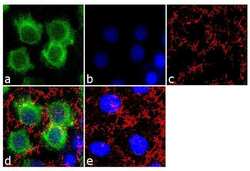
- Experimental details
- Immunofluorescence analysis of Apolipoprotein A1 was performed 70% confluent log phase Hep G2 cells. The cells were fixed with 4% paraformaldehyde for 10 minutes, permeabilized with 0.1% Triton™ X-100 for 10 minutes, and blocked with 2% BSA for 1 hour at room temperature. The cells were labeled with Apolipoprotein A1 (311) Mouse Monoclonal Antibody (Product # MIA1402) at 2 µg/mL in 0.1% BSA and incubated for 3 hours at room temperature and then labeled with Goat anti-Mouse IgG (H+L) Superclonal™ Secondary Antibody, Alexa Fluor® 488 conjugate (Product # A28175) a dilution of 1:2000 for 45 minutes at room temperature (Panel a: green). Nuclei (Panel b: blue) were stained with SlowFade® Gold Antifade Mountant with DAPI (Product # S36938). F-actin (Panel c: red) was stained with Alexa Fluor® 555 Rhodamine Phalloidin (Product # R415, 1:300). Panel d represents the merged image showing cytoplasmic localization. Panel e shows the no primary antibody control. The images were captured at 60X magnification.
- Submitted by
- Invitrogen Antibodies (provider)
- Main image
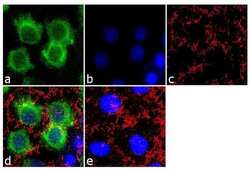
- Experimental details
- Immunofluorescence analysis of Apolipoprotein A1 was performed 70% confluent log phase Hep G2 cells. The cells were fixed with 4% paraformaldehyde for 10 minutes, permeabilized with 0.1% Triton™ X-100 for 10 minutes, and blocked with 2% BSA for 1 hour at room temperature. The cells were labeled with Apolipoprotein A1 (311) Mouse Monoclonal Antibody (Product # MIA1402) at 2 µg/mL in 0.1% BSA and incubated for 3 hours at room temperature and then labeled with Goat anti-Mouse IgG (H+L) Superclonal™ Secondary Antibody, Alexa Fluor® 488 conjugate (Product # A28175) a dilution of 1:2000 for 45 minutes at room temperature (Panel a: green). Nuclei (Panel b: blue) were stained with SlowFade® Gold Antifade Mountant with DAPI (Product # S36938). F-actin (Panel c: red) was stained with Alexa Fluor® 555 Rhodamine Phalloidin (Product # R415, 1:300). Panel d represents the merged image showing cytoplasmic localization. Panel e shows the no primary antibody control. The images were captured at 60X magnification.
Supportive validation
- Submitted by
- Invitrogen Antibodies (provider)
- Main image
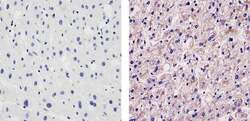
- Experimental details
- Immunohistochemistry analysis of Apolipoprotein A-1 showing staining in the cytoplasm of paraffin-embedded human liver tissue (right) compared to a negative control without primary antibody (left). To expose target proteins, antigen retrieval was performed using 10mM sodium citrate (pH 6.0), microwaved for 8-15 min. Following antigen retrieval, tissues were blocked in 3% H2O2-methanol for 15 min at room temperature, washed with ddH2O and PBS, and then probed with a Apolipoprotein A-1 Mouse Monoclonal Antibody (Product # MIA1402) diluted in 3% BSA-PBS at a dilution of 1:100 for 1 hour at 37ºC in a humidified chamber. Tissues were washed extensively in PBST and detection was performed using an HRP-conjugated secondary antibody followed by colorimetric detection using a DAB kit. Tissues were counterstained with hematoxylin and dehydrated with ethanol and xylene to prep for mounting.
Supportive validation
- Submitted by
- Invitrogen Antibodies (provider)
- Main image
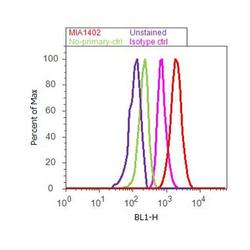
- Experimental details
- Flow cytometry analysis of Apolipoprotein A-1 was done on Hep G2 cells. Cells were fixed with 70% ethanol for 10 minutes, permeabilized with 0.25% Triton™ X-100 for 20 minutes, and blocked with 5% BSA for 30 minutes at room temperature. Cells were labeled with Apolipoprotein A-1 Mouse Monoclonal Antibody (MIA1402, red histogram) or with mouse isotype control (pink histogram) at 3-5 ug/million cells in 2.5% BSA. After incubation at room temperature for 2 hours, the cells were labeled with Alexa Fluor® 488 Rabbit Anti-Mouse Secondary Antibody (A11059) at a dilution of 1:400 for 30 minutes at room temperature. The representative 10,000 cells were acquired and analyzed for each sample using an Attune® Acoustic Focusing Cytometer. The purple histogram represents unstained control cells and the green histogram represents no-primary-antibody control..
Supportive validation
- Submitted by
- Invitrogen Antibodies (provider)
- Main image
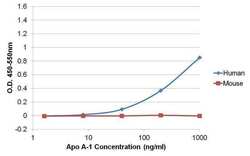
- Experimental details
- Sandwich ELISA of Apolipoprotein A-1 was performed by coating wells of a 96-well plate with 100 µL of an Apo A-1 Recombinant Rabbit Polyclonal Antibody (Product # 710263) diluted to a concentration of 1 µg/mL in carbonate/bicarbonate buffer (Product # 28382) overnight at 4C. Wells were blocked with 150 µL of StartingBlock T20 (TBS) Blocking Buffer (Product # 37543) for 30 minutes, and 80 µL of recombinant human Apo A-1 (Product # 10686-H02H-50) or recombinant mouse Apo A-1 (Product # 50918-M02H-50) was added to the plate at concentrations ranging from 1.6-1000 ng/mL and incubated for 1 hour at room temperature. The plate was washed with 1X TBST (Product # 28360), and 100 µL per well of an Apo A-1 Mouse Monoclonal Antibody (Product # MIA1402) was added to each well for 1 hour at room temperature. The plate was washed, and 100 µL per well of an HRP-conjugated Rabbit anti-Mouse IgG cross-adsorbed secondary antibody (Product # 31452) was incubated for 30 minutes at room temperature. Detection was performed using 1-Step Ultra TMB Substrate (Product # 34028), followed by Stop Solution (Product # N600). Absorbances were read on a spectrophotometer at 450-550 nm.
- Submitted by
- Invitrogen Antibodies (provider)
- Main image
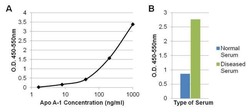
- Experimental details
- Sandwich ELISA of Apolipoprotein A-1 was performed by coating wells of a 96-well plate with 100 µL of an Apo A-1 rabbit monoclonal antibody (Product # 701239) at a concentration of 1 µg/mL in carbonate/bicarbonate buffer (Product # 28382) overnight at 4C. Wells were blocked with 150 µL of StartingBlock T20 (TBS) Blocking Buffer (Product # 37543) for 30 minutes, and 80 µL of recombinant human Apo A-1 (Product # 10686-H02H-50) standards ranging from 1.6-1000 ng/mL (A) or 100 µL of diluted normal human serum or diluted serum from a patient with dyslipidemia (B) were incubated for 1 hour at room temperature. The plate was washed with 1X TBST (Product # 28360), and 100 µL per well of an Apo A-1 mouse monoclonal antibody (Product # MIA1402) was added to each well for 1 hour at room temperature. The plate was washed, and 100 µL per well of a biotinylated rabbit anti-mouse IgG Superclonal? secondary antibody (Product # A27024) was incubated for 1 hour, followed by Streptavidin-HRP (Product # 21126) for 30 minutes. Detection was performed using 1-Step Ultra TMB Substrate (Product # 34028), followed by Stop Solution (Product # N600). Absorbances were read on a spectrophotometer at 450-550 nm.
 Explore
Explore Validate
Validate Learn
Learn